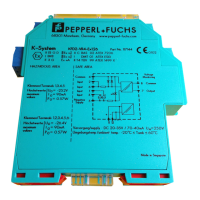Functional Safety KFD2-VR4-Ex1.26
Planning
2018-03
9
3.2 Assumptions
The following assumptions have been made during the FMEDA:
• The device will be used under average industrial ambient conditions comparable to
the classification "stationary mounted" according to MIL-HDBK-217F.
Alternatively, operating stress conditions typical of an industrial field environment similar
to IEC/EN 60654-1 Class C with an average temperature over a long period of time of
40 ºC may be assumed. For a higher average temperature of 60 ºC, the failure rates must
be multiplied by a factor of 2.5 based on experience. A similar factor must be used if
frequent temperature fluctuations are expected.
• The device shall claim less than 15 % of the total failure budget for a SIL 2 safety loop.
• For a SIL 2 application operating in low demand mode the total PFD
avg
value of the
SIF (Safety Instrumented Function) should be smaller than 1 x 10
-2
, hence the maximum
allowable PFD
avg
value would then be 1.5 x 10
-3
.
• For a SIL 2 application operating in high demand mode the total PFH value of the
SIF should be smaller than 1 x 10
-6
per hour, hence the maximum allowable PFH value
would then be 1.5 x 10
-7
per hour.
• Since the safety loop has a hardware fault tolerance of 0 and it is a type A device, the
SFF must be > 60 % according to table 2 of IEC/EN 61508-2 for a SIL 2 (sub) system.
• Failure rate based on the Siemens standard SN29500.
• Any safe failures that occur (e. g. output in safe state) will be corrected within 8 hours
(e. g. remove sensor fault).
• While the device is being repaired, measures must be taken to maintain the safety function
(e. g. substitution by a replacement device).
• Propagation of failures is not relevant.
• There is no signalization of dangerous failures available at the output of the device.
Therefore any fault detection by external safety devices is not assumed.

